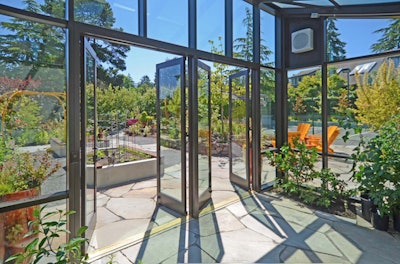
To be successful amid the outdoor living boom, it's critical for retailers and builders to stay abreast of rapidly changing consumer tastes in backyard products. To help keep your product lines up to date, AQUA has partnered with design megasite Houzz to bring you more content about outdoor living, from pools and spas to outdoor kitchens and patio furniture. Here, a Houzz expert digs into popular paving materials.
Paving is a landscape investment, and the cost varies considerably based on the type used and how readily available it is. Cast-in-place concrete is usually the cheapest and most easily installed paving option, but those who live in regions with naturally occurring stone like limestone, granite or slate can use that local stone at a more affordable price.
Related: How to Pick the Right Paving and Deck Material
Here is our guide to some of the most popular paving materials. Whether you are repaving or paving new, you can use this information to understand the basics about paving to make an informed decision based on your situation and where you live.
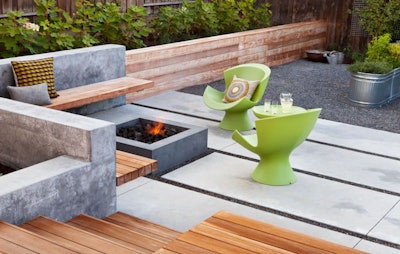
Photo by Arterra Landscape Architects
Cast-in-Place Concrete: Budget-friendliest
Concrete is the standard because it’s affordable, easy to install and easy to maintain. However, cast-in-place concrete doesn’t have to be boring just because it’s the standard. There are many ways to create patterns, textures and colors to liven it up.
Precast Concrete Pavers: Best color and texture variety at an affordable price
Precast concrete pavers are modular pavers that come in a dizzying number of sizes, shapes, colors, textures and patterns. Precast concrete pavers are a great choice for those who want a different look but don’t want to pay for natural stone. Modular permeable systems, which soak up water instead of creating runoff, are available for driveways, walkways and patios.
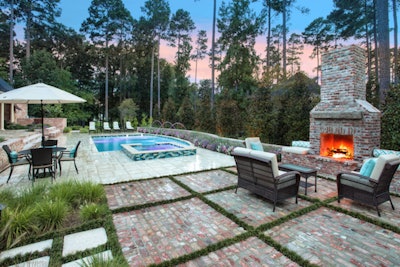
Photo by Morehead Pools
Brick: Classic style and works in all climates
Brick in the standard 4-inch-by-8-inch size can be used to make many fun patterns, including herringbone, without looking too busy, and its reddish tones bring warmth to the garden. Brick also works well with many other hardscapes, which is why you’ll often see it used with wood decks and other paving materials.
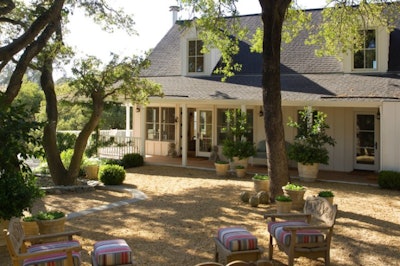
Photo by Butler Armsden Architects
Gravel: Great for permeability and to soften a hardscape
Gravel is available as decomposed stone by the bag or pallet and can be used for paths and patios where you want a softer look. It needs to be bound by some kind of rigid edge, like in the space shown here, to contain it.
Limestone: Great for reflecting heat in hot climates
Limestone is typically white to off-white and sometimes a grayish white. Its light colors make it fantastic for warm climates, where it can reflect heat. It also brings a nice brightness to shaded garden areas.

Photo by Dean Herald-Rolling Stone Landscapes
Travertine: Best for surrounding a pool
Travertine is harder and less porous than its cousin limestone, which makes it somewhat easier to maintain. It stays cool to the touch and makes a lovely poolside surface for bare feet.
Tile: Great colors for warm climates
Tile is bold and funky because it comes in bright and rich colors and is a nice choice for warm climates. It can be tricky to maintain, so be sure you are ready to keep up with tile maintenance.
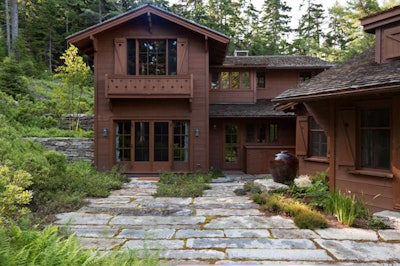
Photo by Matthew Cunningham Landscape Design LLC
Granite: A superior tough stone that’s excellent in cold climates
Granite is expensive, at $14 to $20 per square foot installed, but it may be worth the investment for you because it lasts several lifetimes. If you live near the granite quarries of the Northeast, it’s also a sustainable, local building material.
Slate: Great for cold climates and deep in color
Slate has a deep, rich color and is available in many tones, from deep charcoal to jade green. Slate withstands the coldest climates and works like a champ in the freeze-thaw cycle.
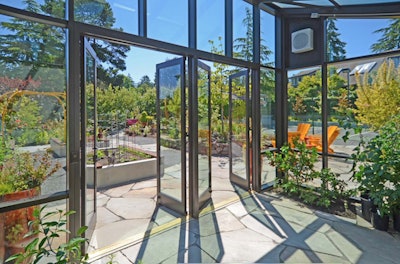 Berger Partnership
Berger Partnership
Photo by Berger Partnership
Bluestone: Elegant, upscale and fantastic in a flagstone pattern
Bluestone is a flaky kind of stone that is broken along its fissure lines to create some of the most elegant flagstones. It’s also available as dimensioned rectangular pavers, if you want a regular pattern for your patio.
Designer tip: Bricks, precast concrete, stone pavers and all the other modular paver types listed here are available for reuse — you just have to know how to find them. Some municipalities have reuse warehouses where residents can pick up salvaged building materials, and some paving suppliers specialize in historic reclaimed granite pavers and street bricks.











































